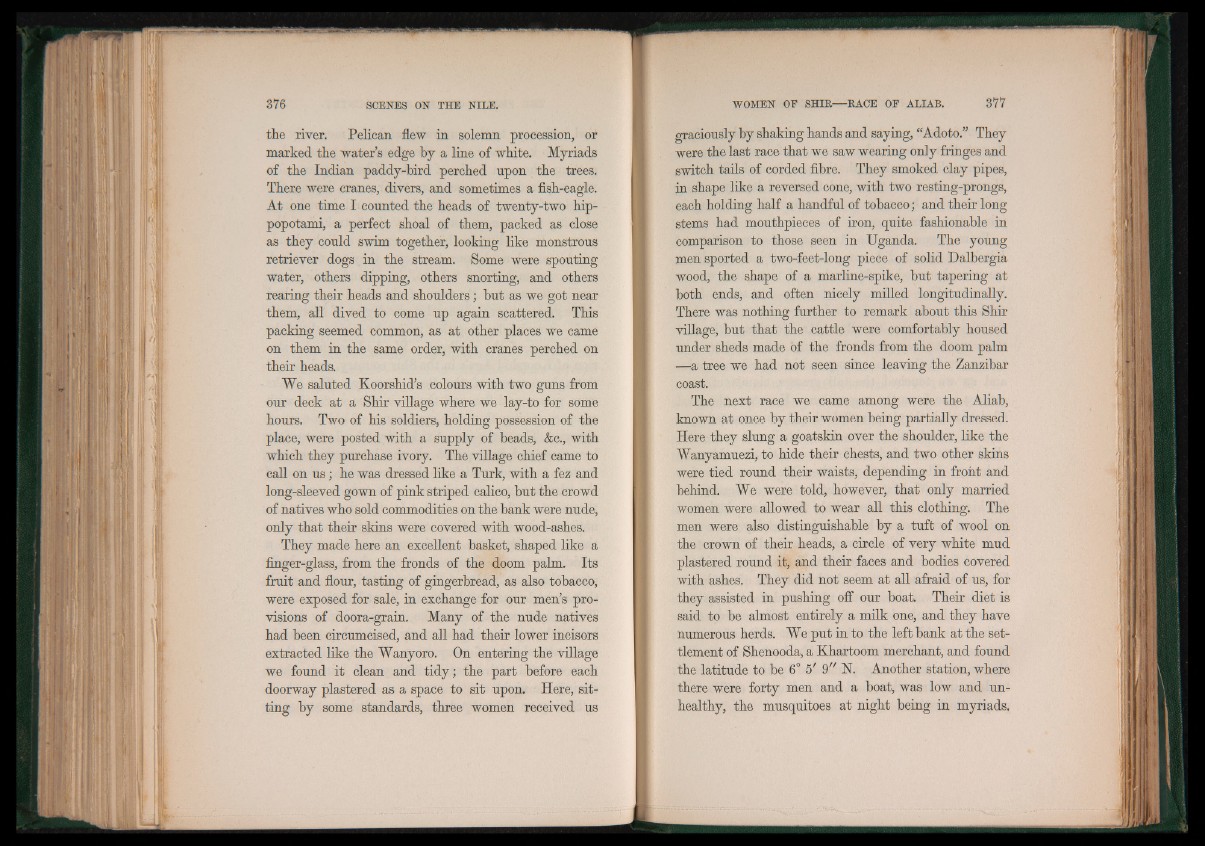
the river. Pelican flew in solemn procession, or
marked the water’s edge by a line of white. Myriads
of the Indian paddy-bird perched npon the trees.
There were cranes, divers, and sometimes a fish-eagle.
At one time I counted the heads of twenty-two hippopotami,
a perfect shoal of them, packed as close
as they could swim together, looking like monstrous
retriever dogs in the stream. Some were spouting
water, others dipping, others snorting, and others
rearing their heads and shoulders; hut as we got near
them, all dived to come up again scattered. This
packing seemed common, as at other places we came
on them in the same order, with cranes perched on
their heads.
We saluted Koorshid’s colours with two guns from
our deck at a Shir village where we lay-to for some
hours. Two of his soldiers, holding possession of the
place, were posted with a supply of beads, &c., with
which they purchase ivory. The village chief came to
call on u s ; he was dressed like a Turk, with a fez and
long-sleeved gown of pink striped calico, but the crowd
of natives who sold commodities on the bank were nude,
only that their skins were covered with wood-ashes.
They made here an excellent basket, shaped like a
finger-glass, from the fronds of the doom palm. Its
fruit and flour, tasting of gingerbread, as also tobacco,
were exposed for sale, in exchange for our men’s provisions
of doora-grain. Many of the nude natives
had been circumcised, and all had their lower incisors
extracted like the Wanyoro. On entering the village
we found it clean and tidy; the part before each
doorway plastered as a space to sit upon. Here, sitting
by some standards, three women received us
graciously by shaking hands and saying, “Adoto.” They
were the last race that we saw wearing only fringes and
switch tails of corded fibre. They smoked clay pipes,
in shape like a reversed cone, with two resting-prongs,
each holding half a handful of tobacco; and their long
stems had mouthpieces of iron, quite fashionable in
comparison to those seen in Uganda. The young
men sported a two-feet-long piece of solid Dalbergia
wood, the shape of a marline-spike, but tapering at
both ends, and often nicely milled longitudinally.
There was nothing further to remark about this Shir
village, but that the cattle were comfortably housed
under sheds made of the fronds from the doom palm
—a tree we had not seen since leaving the Zanzibar
coast.
The next race we came among were the Aliab,
known at once by their women being partially dressed.
Here they slung a goatskin over the shoulder, like the
Wanyamuezi, to hide their chests, and two other skins
were tied round their waists, depending in front and
behind. We were told, however, that only married
women were allowed to wear all this clothing. The
men were also distinguishable by a tuft of wool on
the crown of their heads, a circle of very white mud
plastered round it, and their faces and bodies covered
with ashes. They did not seem at all afraid of us, for
they assisted in pushing off our boat. Their diet is
said to be almost entirely a milk one, and they have
numerous herds. We put in to the left bank at the settlement
of Shenooda, a Khartoom merchant, and found
the latitude to be 6° 5' 9" N. Another station, where
there were forty men and a boat, was low and unhealthy,
the musquitoes at night being in myriads.